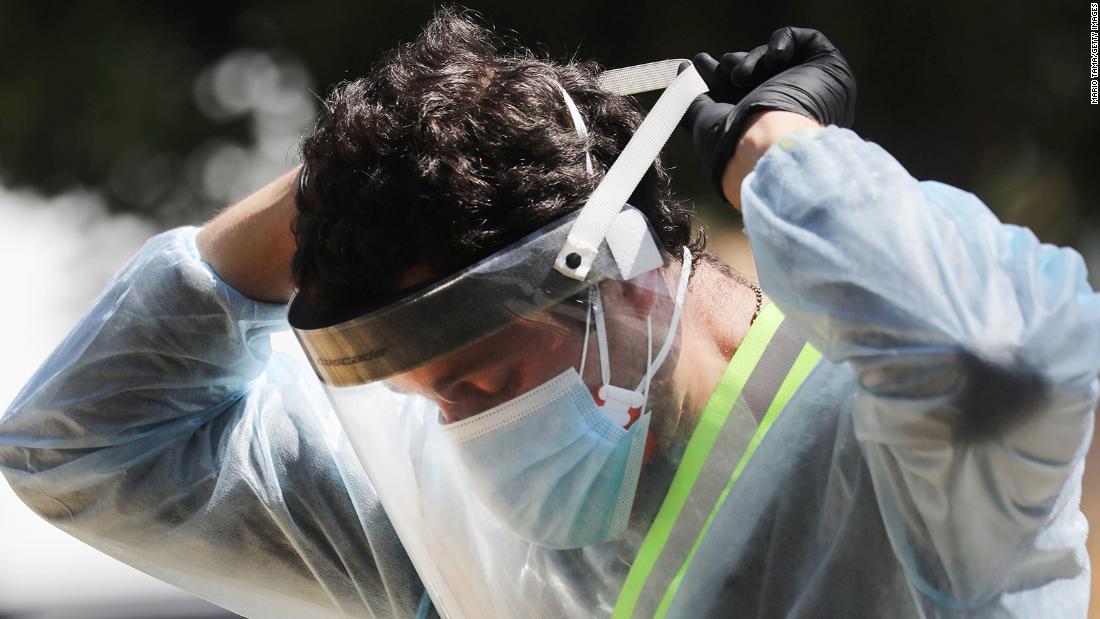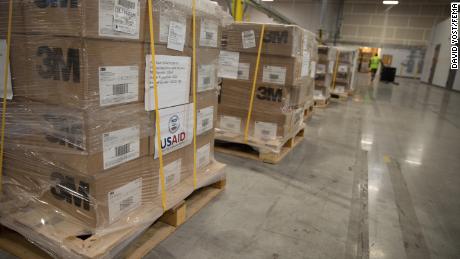The Department of Health and Human Services listed 19 companies that have received contracts under the Defense Production Act to produce emergency supplies, including 600 million N95 respirators and face masks. But experts say it’s not enough and that the effort started far too late.
Only about half the masks ordered will be delivered by the end of this year.
It’s a problem that experts say could’ve been avoided. A former Defense Department official told CNN the administration lost months by not acting aggressively enough with the DPA early on, making it impossible to keep up with demand.
“I think a much more aggressive and early use of the Defense Production Act in probably the February time frame would have saved a lot of the heartaches we are seeing right now with respect to PPE shortages across the country,” said Kelly Magsamen, a former Pentagon official who served as the National Security Council’s senior director for strategic planning during the Obama administration.
In addition to giving out more contracts, Magsamen says, the government could’ve more aggressively used other mechanisms within the DPA, such as tax breaks or loan guarantees, to further incentivize companies to accelerate their production.
“The fact that there wasn’t an organized top-down federal response early and quickly enough, I think, has put us in a position where essentially everybody is playing catch-up, including the Trump administration,” said Magsamen.
White House Trade Adviser Peter Navarro defended the administration’s strategy. “We have not hesitated to use the Defense Production Act when necessary,” he said. “One of the beauties of using the Defense Production Act when necessary is that it has reduced the need to actually have to invoke it because we get voluntary contribution.”
The White House has been reluctant to take too active a role in managing supply production and distribution, putting the onus on states instead. President Donald Trump claims states have all they need — a point Vice President Mike Pence echoed during a coronavirus briefing last week. Pence also said the administration will be issuing renewed guidance on the preservation and reuse of personal protective equipment.
It’s all done little to inspire confidence among those on the front lines.
‘Fragile and overtaxed’
Multiple health care organizations with hospitals in or near current hot spots, including Jackson Health System in Miami, Houston Methodist and Arizona-based Valleywise Health, told CNN they currently have sufficient equipment to protect their workforces. But others have warned of more dire situations.
The National Center for Assisted Living, an industry group, found in a survey of its members in June that more than half of the assisted living facilities had less than two-week supplies of specific protective equipment.
David Voepel, the CEO of the Arizona Health Care Association, which represents skilled-nursing facilities and assisted living communities, told CNN that many assisted living facilities in his state have faced challenges because, in contrast to hospital networks and skilled-nursing facilities, they did not have contracts or established lines of communication with distributors prior to the pandemic.
“The problem is hospitals suck up more of that PPE and the bigger contracts will get the PPE, whereas assisted living communities won’t get it as much,” Voepel said, noting that many assisted living communities are still forced to reuse personal protective equipment.
Nurses are finding themselves in a similar position, despite comments from the administration that hospital capacity remains strong and states have all they need in terms of supplies.
Cortez described situations where the lack of adequate supplies is putting nurses on the front lines of the pandemic in greater danger.
In particular, Cortez says some nurses in Florida are using N95 masks that are not fit-tested. “That’s really putting nurses in danger,” she says, because those masks don’t form the seal around the nose, mouth and chin that would allow the mask to protect the wearer from the virus.
The shortages of PPE have already started to have an adverse impact. Cortez cited a nurse in LA who rushed in, wearing simply a surgical mask, to help a coronavirus patient who had stopped breathing.
“So far, we have 148 nurses that have died because of the coronavirus, simply because they did not have the proper PPE,” Cortez said, noting that figure is only what has been reported to her union and that the actual death toll of nurses is likely higher.
A spokesperson for Banner Health, a health network based in Phoenix with 28 hospitals in the Western US, said it currently has an adequate supply of most protective equipment but that challenges fluctuate, and that recently there’s been a shortage of disposable gowns. To address the issue, the organization deployed reusable cloth gowns.
“Our supply chain has been disrupted in recent months, and we expect this to be ongoing during the pandemic,” the spokesperson said.
Nancy Foster, the American Hospital Association’s vice president for quality and patient safety policy, said the supply chain for protective equipment remains “fragile and overtaxed” due to worldwide demand.
“While in general we would say the supply availability for PPE has gotten better, it is still fragile,” said Foster, who said nitrile gloves, isolation gowns and smaller-sized N95s continue to be a challenge. Foster said the American Hospital Association continues to advocate that the federal government use the DPA to further increase supply.
Dr. Susan Bailey, president of the American Medical Association, said she has heard from physicians across the country that their biggest challenge to reopening their practices is shortages of protective equipment. Bailey said her organization has urged the Trump administration since March to implement a national coordinated strategy on the production, acquisition and distribution of PPE supplies.
Fierce competition
An industry source with knowledge of medical equipment supply chains told CNN that the search for equipment is expected to continue to be fiercely competitive in coming weeks and months, particularly as school systems, the hospitality industry and others enter the market for protective equipment.
Manufacturers have scaled up production, but some warn that keeping pace with the demand is difficult.
“While we are making more respirators than ever before, the reality is demand for respirators continues to exceed supply. This is an industry-wide challenge,” said Tim Post, a spokesperson for 3M, which he said is producing N95 respirators at a rate of more than 50 million per month in the US.
The US Centers for Disease Control and Prevention has issued guidance on reusing N95 masks, but nurses who spoke to CNN argued that the rate with which they are reusing masks has left them vulnerable.
Michelle Brum, a nurse who works in Hyannis, Massachusetts, and co-chairs a nurses’ union, said that months into the outbreak of the virus her hospital continues to keep N95 respirators locked up to prevent staff from using them beyond the allotted amount.
“You’re given one mask and they want you to reuse that mask multiple times,” she said. “The way we were trained is you use it once; when you’re leaving that patient’s room, you take the mask off and it goes in the trash.”
CNN reached out to health departments or other administrative agencies in all 50 states to see how they were doing with personal protective equipment. Twenty-four states responded. Most said their states have adequate PPE in their stockpiles, but six — Missouri, Tennessee, Ohio, Minnesota, Vermont and Alabama — added that N95 masks remain difficult to acquire.
“Although we have heard hospitals are receiving some from manufacturers, we are not able to source them for state purchase, and we understand other health care providers are not able to get them in many cases,” a spokesperson for Missouri’s Department of Health and Senior Services said, referring to N95 masks.
A spokesperson for the Minnesota Department of Administration said that in addition to challenges procuring N95 masks, there is a projected shortage of nitrile gloves. Although the state has about 40 million gloves awaiting delivery, hospitals in the state use almost 1 million each day. “Usage rates and tightening international supply chains create concern for gloves in the near term,” the spokesperson said.
“The broader supply-chain issues have still not been addressed by the Trump administration. We’re still reliant on foreign manufacturing and forced to compete in the global market,” said Casey Katims, a federal liaison for Washington state.
CNN’s Nelli Black and Tara Subramaniam contributed to this report.



